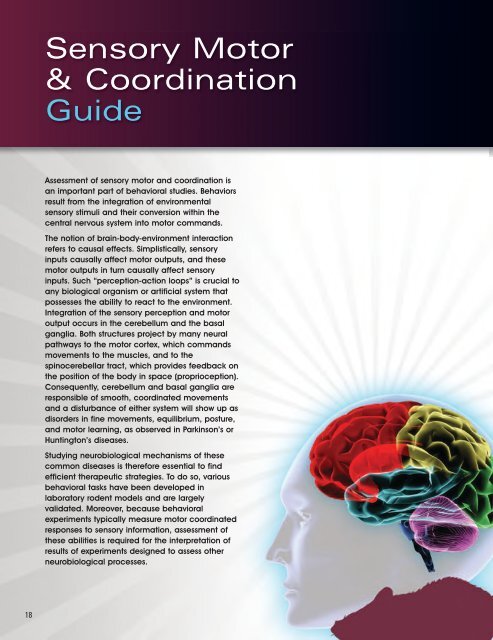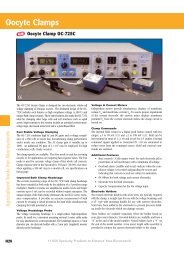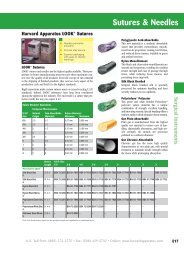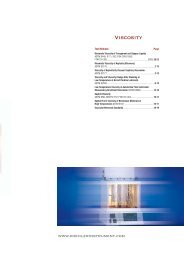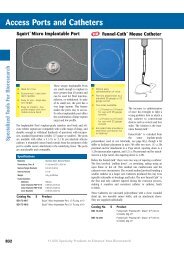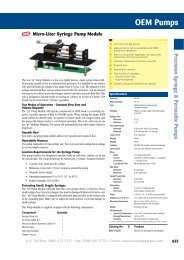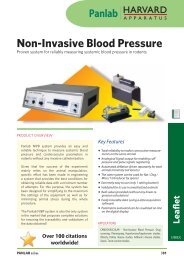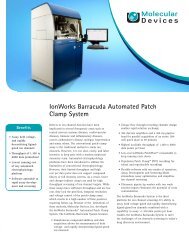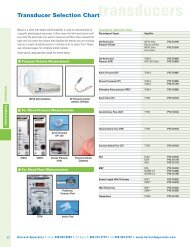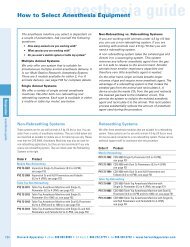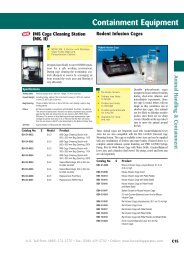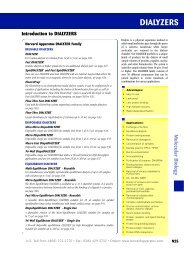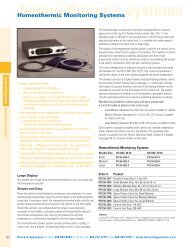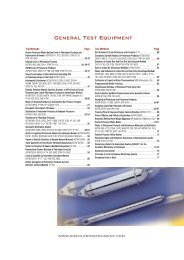Sensory Motor & Coordination Guide
Sensory Motor & Coordination Guide
Sensory Motor & Coordination Guide
You also want an ePaper? Increase the reach of your titles
YUMPU automatically turns print PDFs into web optimized ePapers that Google loves.
<strong>Sensory</strong> <strong>Motor</strong><br />
& <strong>Coordination</strong><br />
<strong>Guide</strong><br />
Assessment of sensory motor and coordination is<br />
an important part of behavioral studies. Behaviors<br />
result from the integration of environmental<br />
sensory stimuli and their conversion within the<br />
central nervous system into motor commands.<br />
The notion of brain-body-environment interaction<br />
refers to causal effects. Simplistically, sensory<br />
inputs causally affect motor outputs, and these<br />
motor outputs in turn causally affect sensory<br />
inputs. Such “perception-action loops” is crucial to<br />
any biological organism or artificial system that<br />
possesses the ability to react to the environment.<br />
Integration of the sensory perception and motor<br />
output occurs in the cerebellum and the basal<br />
ganglia. Both structures project by many neural<br />
pathways to the motor cortex, which commands<br />
movements to the muscles, and to the<br />
spinocerebellar tract, which provides feedback on<br />
the position of the body in space (proprioception).<br />
Consequently, cerebellum and basal ganglia are<br />
responsible of smooth, coordinated movements<br />
and a disturbance of either system will show up as<br />
disorders in fine movements, equilibrium, posture,<br />
and motor learning, as observed in Parkinson’s or<br />
Huntington’s diseases.<br />
Studying neurobiological mechanisms of these<br />
common diseases is therefore essential to find<br />
efficient therapeutic strategies. To do so, various<br />
behavioral tasks have been developed in<br />
laboratory rodent models and are largely<br />
validated. Moreover, because behavioral<br />
experiments typically measure motor coordinated<br />
responses to sensory information, assessment of<br />
these abilities is required for the interpretation of<br />
results of experiments designed to assess other<br />
neurobiological processes.<br />
18
<strong>Sensory</strong> <strong>Motor</strong> & <strong>Coordination</strong> <strong>Guide</strong><br />
Behavioral Test<br />
Rota Rod Test<br />
The Rota Rod is a standard test of motor<br />
coordination, balance and fatigue in rodents.<br />
The animals are placed on moving lanes<br />
rotating at different speeds or under<br />
continuous acceleration, and the time latency<br />
to fall from the Rota Rod is recorded.<br />
Reasons for Choosing This Test<br />
➤<br />
➤<br />
➤<br />
➤<br />
Easy to perform test<br />
Allows multi-animals sessions<br />
Allows evolution curves of performance<br />
Sensitive for both rats and mice<br />
Reasons for Not Choosing This Test<br />
➤<br />
➤<br />
Poor in detecting minor deficits or improvements<br />
in coordination<br />
Needs habituation sessions<br />
Related Human Disease/Applications<br />
➤<br />
➤<br />
➤<br />
➤<br />
➤<br />
➤<br />
<strong>Motor</strong> Phenotyping<br />
Drug Screening<br />
Parkinson’s Disease<br />
Huntington’s Disease<br />
Alcohol Dependence<br />
Aging<br />
Behavioral Test<br />
Grip Strength Test<br />
The purpose of this test is to evaluate the limb<br />
motor or muscular functions in rodents. It<br />
represents a complementary test to the Rota<br />
Rod. Subjects are pulled by the tail while they<br />
are allowed to grasp a grid or a bar. The<br />
maximum force applied to the grid or the bar<br />
just before they lose grip is recorded.<br />
Reasons for Choosing This Test<br />
➤<br />
➤<br />
Easy and rapid test<br />
Sensitive for both rats and mice<br />
Reasons for Not Choosing This Test<br />
➤ High variability in the response<br />
➤ Habituation to the response inducing a loss of<br />
motivation when measurements are performed at<br />
short interval<br />
➤ Influenced by user handling (need training)<br />
Related Human Disease/Applications<br />
➤<br />
➤<br />
➤<br />
➤<br />
➤<br />
➤<br />
Neuromuscular Diseases<br />
Phenotyping<br />
Drug Screening<br />
Parkinson’s Disease<br />
Huntington’s Disease<br />
Aging<br />
19
<strong>Sensory</strong> <strong>Motor</strong> & <strong>Coordination</strong> <strong>Guide</strong><br />
Behavioral Test<br />
Startle Response to<br />
Acoustic and Tactile Stimulus<br />
The startle response is a brainstem reflex<br />
elicited by an unexpected acoustic or tactile<br />
stimulus. The evaluation of startle reflex<br />
response (and its habituation) to acoustic or<br />
tactile stimulus of different intensities is widely<br />
used for the detection of sensorimotor gating<br />
and hearing deficiencies in phenotyping<br />
evaluations.<br />
Reasons for Choosing This Test<br />
➤<br />
➤<br />
➤<br />
Neurological phenotyping for motor and sensory<br />
capabilities<br />
Objective measurement: automated detection of<br />
startle reflex<br />
Sensitive for both rats and mice<br />
Reasons for Not Choosing This Test<br />
➤<br />
➤<br />
Restraint conditions (habituation phase needed)<br />
Non-specific influence of attention processes<br />
Related Human Disease/Applications<br />
➤<br />
➤<br />
➤<br />
➤<br />
➤<br />
➤<br />
Neurological Phenotyping<br />
Hyperekplexia<br />
Auditory Deficits<br />
Parkinson’s Disease<br />
Huntington’s Disease<br />
Schizophrenia<br />
Behavioral Test<br />
Prepulse Inhibition<br />
of Startle Reflex<br />
Prepulse Inhibition (PPI) paradigm is commonly<br />
used to evaluate sensorimotor gating as well as<br />
attentional processes involved in information<br />
selection processing. The startle response is a<br />
brainstem reflex elicited by an unexpected<br />
acoustic or tactile stimulus. In the prepulse<br />
inhibition test, sensorimotor gating is assessed<br />
by evaluating the characteristics of the innate<br />
reduction of the startle reflex induced by a weak<br />
prestimulus. This test measures pre-attentive<br />
processes that operate outside of conscious<br />
awareness and is widely used in animal models<br />
of diseases marked by an inability to inhibit, or<br />
“gate” irrelevant information in sensory, motor,<br />
or cognitive domains.<br />
Reasons for Choosing This Test<br />
➤<br />
➤<br />
➤<br />
Reproduces the same paradigm used in humans to<br />
detect attentional and sensorimotor gating disorders<br />
Objective measurement: automated detection of<br />
startle reflex<br />
Sensitive for both rats and mice<br />
Reasons for Not Choosing This Test<br />
➤<br />
➤<br />
Restraint conditions (habituation phase needed)<br />
Influenced by non-specific effects on<br />
sensorimotor gating<br />
Related Human Disease/Applications<br />
➤<br />
➤<br />
➤<br />
➤<br />
➤<br />
➤<br />
➤<br />
➤<br />
➤<br />
Drug Screening<br />
Phenotyping<br />
Attention-Deficit Hyperactivity Disorder (ADHD)<br />
Schizophrenia<br />
Autism<br />
Obsessive Compulsive Disorder<br />
Huntington’s Disease<br />
Nocturnal Enuresis<br />
Tourette’s Syndrome<br />
20
<strong>Sensory</strong> <strong>Motor</strong> & <strong>Coordination</strong> <strong>Guide</strong><br />
Behavioral Test<br />
Rotameter Test<br />
Rotational behavior has proved a popular<br />
technique for screening the behavioral effects<br />
of a wide variety of lesions, drugs, and other<br />
experimental manipulations on the brain of<br />
rodents. This test is widely carried out in<br />
experiments using animal models of<br />
Parkinson disease with unilateral lesions in the<br />
dopaminergic nigrostriatal system in which<br />
the number and direction of animal rotations<br />
in quantified after apormorphine treatment.<br />
Reasons for Choosing This Test<br />
➤<br />
➤<br />
Rapid and easy-to-do test<br />
Can be entirely automated<br />
Related Human Disease/Applications<br />
➤<br />
➤<br />
Drug Screening<br />
Parkinson’s Disease<br />
Behavioral Test<br />
Treadmill<br />
The Treadmill Test in rodents is a useful tool with<br />
a great value in the study of functional capacity.<br />
It is a validated standard model for<br />
investigations in the field of human metabolism.<br />
A subject is forced to walk/run on a treadmill<br />
(adjustable speed and inclination) during specific<br />
periods of time. This test allows the study of<br />
various physiological and behavioral functions<br />
such as long and short-term effort during<br />
exercise, locomotion, metabolic exchanges,<br />
cardiac function, motor coordination and fatigue.<br />
Reasons for Choosing This Test<br />
➤ Adapted from a human test<br />
➤ Allows the researcher to precisely control the level<br />
of exertion<br />
➤ Easy to use, even for inexperienced users<br />
➤ Sensitive for mice and rats<br />
Reasons for Not Choosing This Test<br />
Behavioral Test<br />
Activity Wheel<br />
The Rodent Activity Wheel represents a very<br />
simple and clever way to register animal<br />
physical activity in its home cage environment.<br />
The use of this high throughput tool is<br />
particularly relevant for research involving<br />
circadian rhythms, phenotyping and drug<br />
testing. The time and distance run on a<br />
voluntary running wheel are monitored over<br />
several days or weeks to determine whether a<br />
particular substance or experimental<br />
manipulation has an effect on exercise behavior.<br />
Reasons for Choosing This Test<br />
➤<br />
➤<br />
➤<br />
➤<br />
➤<br />
➤<br />
Rodent voluntary exercise registering; allows<br />
animals to exercise when and at the intensity that<br />
they choose<br />
Accessibility to running wheel may reduce the<br />
effects of chronic stress on depression-like signs<br />
in mice<br />
Less labor intensive than treadmill running as<br />
researchers need not to be present during wheel<br />
running<br />
Relatively inexpensive setup<br />
Ideal for high throughput experiments; many animals<br />
can be trained at the same time<br />
Sensitive for both mice and rats<br />
Reasons for Not Choosing This Test<br />
➤<br />
➤<br />
➤<br />
Intensity and duration of the exercise cannot be<br />
controlled<br />
Certain lines of transgenic mice may not engage in<br />
enough voluntary wheel running exercise to produce<br />
training adaptations<br />
Not suitable for studies that require precise timing<br />
to explore acute post exercise adaptations<br />
(intermittent running throughout the active cycle)<br />
Related Human Disease/Applications<br />
➤<br />
➤<br />
➤<br />
➤<br />
➤<br />
Drug Screening<br />
Phenotyping<br />
Neuromuscular Disease<br />
Parkinson’s Disease<br />
Muscular Dystrophy<br />
➤<br />
➤<br />
➤<br />
Needs repetitive daily exposure<br />
lasting several weeks<br />
Requires constant vigilance by<br />
the researcher to make sure that<br />
the animals run for the entire<br />
exercise test time<br />
Use of aversive stimuli to<br />
encourage running<br />
Related Human Disease/Applications<br />
➤ Improvement of sportive human performances<br />
➤ Oxidative Stress<br />
➤ Diabetes<br />
➤ Parkinsons’s Disease<br />
➤ Ischemia<br />
➤ Ostopenia/Osteoporosis<br />
21
Rota Rod for <strong>Motor</strong> <strong>Coordination</strong> in Rodents<br />
<strong>Sensory</strong> & <strong>Motor</strong> I Rota Rod for <strong>Motor</strong> <strong>Coordination</strong> in Rodents<br />
Rota Rod<br />
Key Features<br />
➤ Combined Rota Rod for mice and rats available!<br />
➤ Mechanical detection of fall<br />
➤ Individual lane timers<br />
➤ Constant speed and fixed acceleration rate modes<br />
➤ Automatic recording of latencies to fall and rotation speed<br />
➤ Memory for storing data<br />
➤ Data Transfer software included (SeDaCom)<br />
Parameters Measured<br />
➤ Animal latency to fall<br />
➤ Rotation speed when fall occurs<br />
Components Included<br />
➤ Rota Rod unit with integrated control unit and<br />
RS-232 communication’s port<br />
➤ Cylinder for mice, rats or both depending on the model<br />
➤ Extension hood for rats (only for LE8300 and LE8500)<br />
➤ SeDaCom software<br />
➤ Cables and connectors<br />
➤ Certificate of calibration<br />
➤ Instruction manual<br />
➤ Set of spare fuses<br />
➤ 2 year warranty<br />
Options<br />
➤ LE7000 thermal printer<br />
Rota Rod<br />
The Panlab/Harvard Apparatus Rota Rod provides an easy way to test<br />
the effects of drugs, brain damage, or diseases on motor coordination or<br />
fatigue resistance in rodents.<br />
The animal is placed on the roller lane of the Rota Rod and the timer is<br />
started. When the animal drops safely into its own lane, the time latency<br />
to fall (minutes and seconds) and rotation speed are automatically<br />
recorded. A removable upper separator for rat models is included to<br />
prevent interference between animals running in adjacent lanes.<br />
The Rota Rod is controlled by an advanced microprocessor which provides<br />
precise timing control and ultra-accurate speed regulation. Rotation can<br />
be electronically set at a constant speed (4-40 rpm) using a dial on the<br />
front panel. Alternatively, acceleration rate may be selected at a defined<br />
time (30 sec., 1, 2, 5 or 10 min). Acquired data is saved in the form of a<br />
table-lanes/trials. The Panlab/Harvard Apparatus Rota Rod is also<br />
provided with a computer interface enabling easy exportation of data<br />
through RS-232 serial port in a format that is compatible with Excel .<br />
Specifications<br />
Unit Dimensions<br />
Extra Hood<br />
Lane and Rod<br />
Dimensions-Rats<br />
Lane and Rod<br />
Dimensions-Mice<br />
Material Composition<br />
Constant Speeds<br />
Acceleration Rate<br />
362 (W) x 240 (D) x 400 (H) mm<br />
100 (H) mm<br />
75 mm (W); 60 mm rod diameter<br />
50 mm (W); 30 mm rod diameter<br />
Methacrylate, arnite (lanes)<br />
4-40 RPM<br />
30 seconds, 1, 2, 5, or 10 minutes<br />
Computer Requirements PC (Windows ® 95, 98, ME, NT, 2000, XP & Vista 32)<br />
Maximum Number of<br />
Stations<br />
Certifications<br />
Power Requirements<br />
Order # Model<br />
1 per computer (multiple set-ups also available<br />
under request)<br />
CE compliant<br />
110/220 V, 50/60 Hz<br />
Product<br />
BH2 76-0237 LE 8200 Accelerating Rota Rod for<br />
5 Mice Including SeDaCom Software<br />
BH2 76-0238 LE 8300 Accelerating Rota Rod for<br />
4 rats Including SeDaCom Software<br />
BH2 76-0239 LE 8500 Accelerating Rota Rod for<br />
4 Rats or 4 Mice Including SeDaCom Software<br />
OPTIONS<br />
BH2 76-0114 LE 7000 Thermal Printer<br />
Citations<br />
Favre-Guilmard C et al. (2009) Different antinociceptive effects of botulinum toxin type A in<br />
inflammatory and peripheral polyneuropathic rat models . Eur. J. Phar. 617(1-3): 48-53 (rat, France)<br />
Marino P et al. (2009) A polysialic acid mimetic peptide promotes functional recovery in a mouse<br />
model of spinal cord injury. Exp Neurology, 219(1):163-174. (spinal cord injury, mouse, France)<br />
Viosca J et al. (2009) Germline expression of H-RasG12V causes neurological deficits associated to<br />
Costello syndrome. Genes, Brain and Behav. 8(1):60-71. (mouse, France)<br />
Favre-Guilmard C et al. (2008) The novel inhibitor of the heterotrimeric G-protein complex, BIM-46187,<br />
elicits anti-hyperalgesic properties and synergizes with morphine. Eur. J. Phar. 594(1-3): 70-76 (rat, France)<br />
Korhonen L et al. (2008) Expression of X-chromosome linked inhibitor of apoptosis protein in mature<br />
purkinje cells and in retinal bipolar cells in transgenic mice induces neurodegeneration. Neuroscience<br />
156(3):515-526 (LE8200, mouse, Finland)<br />
22<br />
Harvard Apparatus • phone 508.893.8999 • toll free U.S. 800.272.2775 • fax 508.429.5732 • www.harvardapparatus.com<br />
Panlab | Harvard Apparatus • Spain +34934190709 • International +34834750697 • fax +34934750699 • www.panlab.com
Grip Strength Meter for Evaluation of Muscular Strength<br />
Grip Test Accessories<br />
Bar for Rat<br />
(for front or rear paws)<br />
Bar for Mouse<br />
(for front or rear<br />
paws)<br />
Grid for Rats<br />
(for four paws)<br />
Grid for Mouse<br />
(for front paws<br />
& four paws)<br />
Grip Strength Meter<br />
The grip strength meter allows the study of neuromuscular functions<br />
in rodents by determining the maximum force displayed by an animal.<br />
This test is included in the Functional Observational Battery (FOB) to<br />
screen for neurobehavioral toxicity. In this context, changes in grip<br />
strength are interpreted as evidence of motor neurotoxicity.<br />
The grip strength meter is positioned horizontally and the subjects<br />
are held by the tail and lowered towards the apparatus. The animals<br />
are allowed to grasp the metal grid or T-bar and are then pulled<br />
backwards in the horizontal plane. The force applied to the grid or to<br />
the bar just before it loses grip is recorded as the peak tension. This<br />
force can be measured in kilograms, grams, pounds or Newtons.<br />
Data output is carried out through RS-232, printer, or chart recorder.<br />
Depending on the grid type used, grip strength can be measured from<br />
the front or hind paws.<br />
Specifications<br />
Dimensions of 2 Grid System<br />
Sensor Capacity<br />
Sampling Speed<br />
Measurement Range<br />
Resolution<br />
Accuracy<br />
Material Composition<br />
Power Supply<br />
750 (W) x 180 (D) x 200 (H) mm<br />
0-2 kG (20N)<br />
1000 Hz<br />
0 to 2000 grams<br />
0.1 gram<br />
0.2 % of full scale<br />
Stainless steel (Grid)<br />
110 V/220 V<br />
<strong>Sensory</strong> & <strong>Motor</strong> I Grip Strength Meter for Evaluation of Muscular Strength<br />
Dimensions of Single System<br />
400 (W) x 180 (D) x 200 (H) mm<br />
Key Features<br />
➤ Stand alone system, PC optional, not required<br />
➤ Fits to rats and mice with a simple change of grip accessories<br />
➤ Multi-units display: kgs, grams, lbs, Newtons<br />
➤ New and unique internal computations allows direct<br />
reading of average value, standard deviation and<br />
variability for subjects and up to 100 animals<br />
Parameters Measured<br />
➤ Maximum force developed by the front and hind paws<br />
Components Included<br />
➤ Display unit with RS-232 connection for PC<br />
➤ Metal stand<br />
➤ Grid or bar (one or two grids/bar)<br />
➤ Instruction manual<br />
➤ 1 year warranty<br />
Options<br />
➤ RS-232 cable<br />
➤ RSIC software<br />
➤ Additional grid/bar<br />
➤ Statistical impact printer with cable<br />
Order # Model<br />
Product<br />
BH2 76-0483 BSBIOGS3 Grip Strength Test Complete with 1<br />
Accessory, 110 or 220 Volts<br />
BH2 76-0484 BSBIORSIC Data Acquisition RSIC Software Windows ®<br />
XP (Dongle and CD)<br />
BH2 76-0485 BSBIOAGRS232 RS-232 Cable<br />
BH2 76-0479 BSBIOGRIPBR Bar for Rats (Front Paws)<br />
BH2 76-0480 BSBIOGRIPBS Bar for Mice (Front or Rear Paws)<br />
BH2 76-0481 BSBIOGRIPGR Grid for Rats (Front or Four Paws)<br />
BH2 76-0482 BSBIOGRIPGS Grid for Mice (Front & Four paws)<br />
Citations<br />
Dudra-Jastrzebska et al. (2009) Pharmacodynamic and pharmacokinetic interaction profiles of levetiracetam<br />
in combination with gabapentin, tiagabine and vigabatrin in the mouse pentylenetetrazole-induced seizure<br />
model: An isobolographic analysis. Eur. J. Pharmacol. 605(1-3): 87-94. (mouse, Poland, UK)<br />
Dupuis L et al. (2009) Muscle Mitochondrial Uncoupling Dismantles Neuromuscular Junction and<br />
Triggers Distal Degeneration of <strong>Motor</strong> Neurons. PLoS ONE 4(4):e5390. (mouse, France)<br />
Kozinska J et al (2009) Spironolactone potentiates the protective action of some selected antiepileptic<br />
drugs against maximal electroshock-induced seizures in mice. Annales UMCS, Pharmacia. 22(1):123-<br />
134. (mouse, Poland)<br />
Lambertsen KL et al. (2009) Microglia Protect Neurons against Ischemia by Synthesis of Tumor<br />
Necrosis Factor. J. Neurosci. 29(5):1319-1330. (BIO-GT3, mouse, Denmark, Sweden).<br />
Luszczki JJ et al. (2009) N-(anilinomethyl)-p-isopropoxyphenylsuccinimide potentiates the<br />
anticonvulsant action of phenobarbital and valproate in the mouse maximal electroshock-induced<br />
seizure model Neurosci. Res. 64(3):267-272. (mouse, Poland, Armenia)<br />
Akhtar M et al. (2008) Effect of thioperamide on oxidative stress markers in middle cerebral artery occlusion<br />
model of focal cerebral ischemia in rats. Human & Experimental Toxicology. 27(10):761-767. (rat, India)<br />
Harvard Apparatus • phone 508.893.8999 • toll free U.S. 800.272.2775 • fax 508.429.5732 • www.harvardapparatus.com<br />
Panlab | Harvard Apparatus • Spain +34934190709 • International +34834750697 • fax +34934750699 • www.panlab.com<br />
23
Grip-Strength Meter<br />
<strong>Sensory</strong> & <strong>Motor</strong> I Grip-Strength Meter<br />
Both the Grip Strength Meter for Rats and the model for Mice are<br />
used with this Peak Amplifier. It automatically discriminates whether<br />
the grip force is generated by the rat and mouse transducer and<br />
expresses them in grams and in decimal of grams respectively.<br />
The data supplied by the peak amplifier is available in digital and<br />
analog form. The waveform of the pull can be externally recorded, for<br />
example via a channel recorder or the signal may be taken to a data<br />
acquisition system.<br />
Grip-Strength Meter is Supplied<br />
Complete with the Following Components<br />
• Peak Amplifier, incorporating a digital display<br />
• Force Transducer suitable for either Rats or Mice<br />
• Trapezes for either Rats or Mice, T-shaped bar<br />
for either Rats or Mice<br />
• Perspex Plate with 10 mm diameter upright<br />
• Open-Side Boss Head<br />
• Table Clamp<br />
• Mains Cable<br />
• Set of 2 fuses for either 115 V or 230 V operation<br />
• Instruction Manual<br />
Grip-Strength Meter<br />
This system measures the force that is required to make a mouse or<br />
rat release its grip. It is ideal to measure the effects of drugs, toxins,<br />
muscle relaxants, disease, aging or neural damage on muscle<br />
strength.<br />
The rat or mouse is placed over a Perspex plate, in front of a grasping<br />
bar, either T-shaped or trapeze-shaped. Rodents instinctively grab<br />
anything they can to try to stop this involuntary backward movement.<br />
The will continue to grip the trapeze until the pulling force overcomes<br />
their grip strength. After the animal loses its grip, the peak<br />
preamplifier automatically stores the peak pull force and shows it on<br />
a liquid crystal display.<br />
The sensor mechanism is a T-shaped or trapeze-shaped bar whose<br />
height is adjustable. The bar is fitted to a force transducer connected<br />
to the Peak Amplifier. The Mouse unit is similar to the rat model except<br />
the grasping trapeze is proportionately sized for mice and the<br />
transducer sensitivity is adjusted to measure the grip strength of mice.<br />
A complete system is comprised of the follow components:<br />
1. A base plate of black sand-blasted Perspex,<br />
complete with upright and open-side boss-head<br />
2. A grasping-bar (a grasping trapeze is also supplied)<br />
3. A force transducer of adjustable height, provided with<br />
connection cable and connector to the peak amplifier<br />
4. A peak amplifier<br />
Peak Preamplifier<br />
Order # Model Product<br />
BH2 72-6713 47105 Grip-Strength Meter for Rats<br />
BH2 72-6715 47106 Grip-Strength Meter for Mice<br />
REPLACEMENT PARTS<br />
BH2 72-6717 47105-002 Force Transducer Assembly for Rat<br />
BH2 72-6718 47105-003 Force Transducer Assembly for Mouse<br />
BH2 72-6719 47105-004 Pespex Plate with 10 mm Diameter Upright<br />
BH2 72-6723 47105-323 Table Clamp<br />
BH2 72-6725 4003 Open-Side Boss Head<br />
24<br />
Harvard Apparatus • phone 508.893.8999 • toll free U.S. 800.272.2775 • fax 508.429.5732 • www.harvardapparatus.com<br />
Panlab | Harvard Apparatus • Spain +34934190709 • International +34834750697 • fax +34934750699 • www.panlab.com
Rodent Activity Wheel<br />
Activity Wheel and Cage<br />
<strong>Sensory</strong> & <strong>Motor</strong> I Rodent Activity Wheel<br />
Key Features<br />
➤ Easy way to quantify rodent voluntary exercise in their home<br />
cage environment<br />
➤ Preserves animal living space<br />
➤ Stainless steel wheel construction<br />
➤ For rat, mice and hamsters<br />
➤ Ideal for high throughput experiments<br />
Applications<br />
➤ Activity - circadian rhythms, exercise<br />
➤ Cognition - environmental enrichment<br />
➤ Disease models - Huntington’s, Attention-Deficit Hyperactivity<br />
Disorder, Addiction, Anorexia and more<br />
Rodent Activity Wheel<br />
The Rodent Activity Wheel represents a very simple and clever way<br />
to register animal voluntary physical activity in its home cage<br />
environment.<br />
The use of this high throughput tool is particularly relevant for<br />
research involving circadian rhythms, phenotyping and drug testing.<br />
The animals are housed individually in the home cages equipped with<br />
the running wheel.<br />
The total number of wheel rotation made by the animal is displayed<br />
on the external LE907 individual counter or LE3806 multi-counter<br />
devices. LE3806 multi-counter allows storing the data in user-defined<br />
time intervals and exports them to the SeDaCom PC interface<br />
(through RS-232 serial port) in a format compatible with Excel .<br />
All the components of the wheel assembly (wheel, wheel hub and<br />
support) are made of stainless steel and are used with standard ACE<br />
(Allentown Caging Equipment) polycarbonate rodent cages provided<br />
with its wire lid. The wheel is mounted outside the home cage to<br />
preserve animal living space.<br />
All non-electrical cage components are autoclavable.<br />
Specifications<br />
Model Ø Wheel Lane Width ACE* Cage Size<br />
LE904 36 cm 10 cm 42 (W) x 26 (D) x 19 (H) cm<br />
LE905 16 cm 6 cm 36 (W) x 20 (D) x 14 (H) cm<br />
* Other brands are available under request<br />
Order # Model<br />
Product<br />
BH2 76-0412 LE904 Activity Wheel and Cage, Rat<br />
BH2 76-0413 LE905 Activity Wheel and Cage, Mouse<br />
OPTIONS<br />
BH2 76-0414 LE907 Single Wheel Counter<br />
BH2 76-0243 LE3806 Multi-Counter (up to 30 wheels) including<br />
SedaCom PC interface<br />
Harvard Apparatus • phone 508.893.8999 • toll free U.S. 800.272.2775 • fax 508.429.5732 • www.harvardapparatus.com<br />
Panlab | Harvard Apparatus • Spain +34934190709 • International +34834750697 • fax +34934750699 • www.panlab.com<br />
25
Rodent Activity Wheel and Cage<br />
<strong>Sensory</strong> & <strong>Motor</strong> I Rodent Activity Wheel and Cage<br />
BH2 60-1943 Rodent Activity Wheel and Cage shown complete with<br />
Water Bottle, Waste Tray, Support Stand and Counter (not included)<br />
The clear polycarbonate cage has glass-like clarity and excellent<br />
impact strength. The cut-out bottom allows changing of bedding and<br />
removal of excreta without disturbing the animal. (Meets NIH floor<br />
space requirements for a single rodent). A solid stainless steel lid<br />
covers the opening at the edge of the Activity Wheel while a wire lid<br />
with exclusive lid locks fasten securely to the cage body. These lids<br />
prevent the animal from escaping. The wire lid incorporates a water<br />
bottle support with rubber stopper guard and a U-shaped food hopper<br />
for pellets.<br />
Specifications<br />
Dimensions:<br />
Overall, H x W x D<br />
Wheel, OD x W<br />
Floor Area:<br />
36.4 x 26.8 x 50 cm (14.25 x 10.375 x 19.5 in)<br />
34.5 x 9 cm (13.5 x 3.5 in)<br />
Cage 929 cm 2 (144 in 2 )<br />
Cage with Wheel 516 cm 2 (80 in 2 )<br />
Order # Product<br />
FOR RATS<br />
Key Features<br />
➤ Easy measurement of rodent activity<br />
➤ For mice, rats and hamsters<br />
➤ All stainless steel wheel construction<br />
➤ Clear polycarbonate cage for visibility and strength<br />
Rodent Activity Wheel<br />
This Rodent Activity Wheel provides an easy, convenient method for<br />
measuring lab rodents’ physical activity in response to chemical or<br />
environmental stimuli. It is especially useful for research involving<br />
circadian rhythms or pharmaceutical testing. The Rodent Activity<br />
Wheel and Cage package comes complete with: stainless steel<br />
activity wheel, wheel hub and support, sheet and activity wire lids<br />
and polycarbonate cage with cut away bottom and stainless steel<br />
floor grid.<br />
The Activity Wheel allows the animal to exercise voluntarily. It has<br />
long-lasting, low-friction Teflon TFE bushings for quiet, smooth action.<br />
The stainless steel hub and support rod provide strength and<br />
durability and the wide wheel allows small to large animals to<br />
exercise. A magnetic switch with LCD counter is available as an<br />
accessory for recording animal activity on the wheel, counted as<br />
wheel revolutions. The magnetic switch can be used with both the rat<br />
and mouse wheels.<br />
BH2 60-1943<br />
BH2 60-1944<br />
BH2 60-1945<br />
BH2 60-0506<br />
BH2 60-1946<br />
FOR MICE<br />
BH2 60-2429<br />
BH2 60-2425<br />
BH2 60-2423<br />
BH2 60-2424<br />
BH2 60-1946<br />
Rat Activity Wheel and Cage<br />
Polycarbonate Waste Tray Collects Excreta,<br />
H x W x D, 3.5 x 28 x 45 cm (1.375 x 11.125 x 17.5 in); Requires<br />
Use of BH2 60-1945 Support Stand, see below, pkg. of 1<br />
Support Stand for Cage and Waste Tray for Rat Cage,<br />
Stainless Steel, Supports One Activity Cage with Wheel<br />
and Waste Tray; Allows Removal of Waste Tray without<br />
Disturbing the Cage or Animal<br />
Polycarbonate Water Bottle for Rat Cage, 500 ml Glass Clear<br />
and Shatterproof. Extremely Rugged. Permanent, Molded-in<br />
Graduations for Easy Measurement. Complete with Chew-<br />
Proof Type 316 SS Cap and Sipper tube. Exclusive 1.8 mm<br />
Sipper Tube Opening Minimizes Spontaneous Dripping<br />
Magnetic Switch with LCD Counter the Magnetic Switch Counts<br />
Whole Revolutions of the Activity Wheel. Operates on an<br />
Extended-Life Battery (Included). A Safety Lock Position on the<br />
Reset Button Helps Eliminate Accidental Resettings. Assembly<br />
Required to Connect Unit to the Activity Wheel and Cage. Works<br />
with Both Rat and Mouse Wheel.<br />
Mouse Activity Wheel and Cage<br />
Polycarbonate Waste Tray for Mouse Cage<br />
Support Stand for Cage and Waste Tray for Mouse Cage<br />
Polycarbonate Water Bottle for Mouse Cage<br />
Magnetic Switch with LCD Counter, see Description Above<br />
26<br />
Harvard Apparatus • phone 508.893.8999 • toll free U.S. 800.272.2775 • fax 508.429.5732 • www.harvardapparatus.com<br />
Panlab | Harvard Apparatus • Spain +34934190709 • International +34834750697 • fax +34934750699 • www.panlab.com
Rotameter for Evaluating Rotation Behavior<br />
Rotameter<br />
Key Features<br />
➤ Rotation sensor with adjustable TTL output signal<br />
➤ Configuring experiment duration and time intervals of counting<br />
➤ Counting the number of partial and complete left and right turns<br />
➤ Adjustable harness with velcro<br />
➤ Computer interface included<br />
Parameters Measured<br />
➤ Number of partial and complete left and right turns<br />
Components Included<br />
➤ Rotation sensor and support<br />
➤ Animal harness<br />
➤ Container (either a bowl or a cylinder)<br />
➤ SeDaCom software<br />
➤ Cables and connectors<br />
➤ Instruction manual<br />
➤ 2 year warranty<br />
Options<br />
➤ Double counter (left & right turn)<br />
➤ Programmable counter with 30 inputs (up to 15 Rotameters)<br />
and SeDaCom software<br />
Rotameter<br />
Rotational behavior has proved a popular technique for screening the<br />
behavioral effects of a wide variety of lesions, drugs, and other<br />
experimental manipulations on the brain of rodents. This test is widely<br />
carried out in experiments using animal models of Parkinson’s Disease<br />
with unilateral lesions in the dopaminergic nigrostriatal system.<br />
The subject wears an adjustable harness with velcro connected to the<br />
rotation sensor by a flexible tie. Wide ranges of harnesses are available<br />
to fit different animal sizes. The subject is then placed into a transparent<br />
container (cylindrical or oval) with a lateral support for a vertical stand.<br />
A bi-directional rotation sensor provides a double (right and left turns)<br />
output with adjustable regulation of pulses/turns (between 3 and 36<br />
pulses per complete turn). Experiment duration and time intervals of<br />
measurement can be set. An external multicounter LE3806 is<br />
necessary for data storage; it counts the number of partial and<br />
complete left and right turns depending of the adjustments made on<br />
the rotation sensors.<br />
The computer interface SeDaCom allows easy exportation of data<br />
(through RS-232 serial port) in a format compatible with Excel .<br />
Specifications<br />
Fraction of Turn<br />
Dimensions of the<br />
Containers<br />
4 to 36 fraction of a circumference (selectable)<br />
400 mm diameter<br />
Computer Requirements PC (Windows ® 95, 98, ME, NT, 2000, XP & Vista 32)<br />
Order # Model<br />
Product<br />
BH2 76-0241 LE902 Rotational System Including Rotation<br />
Sensor, Rat or Mouse Harness, Bowl<br />
or Cylinder Container<br />
BH2 76-0242 LE902-CC Double Counter (Left & Right Turns)<br />
BH2 76-0243 LE3806 Programmable MultiCounter with 30 Inputs<br />
(up to 15 Rotameters) and SedaCom Software<br />
OPTIONS<br />
BH2 76-0244 LE902-SR Left & Right Rotation Sensor,<br />
Adjustable Turn Resolution<br />
BH2 76-0245 LE902-AS Rat Harness with Velcro<br />
and Connecting Wire<br />
BH2 76-0246 LE902-MT Mouse Harness with Velcro<br />
and Connecting Wire<br />
BH2 76-0247 LE902-RP Cylindrical or Oval Container<br />
with Supporting Rod<br />
Citations<br />
Belzunegui S et al. (2008) Striatal carotid body graft promotes differentiation of neural progenitor<br />
cells into neurons in the olfactory bulb of adult hemiparkisonian rats. Brain Res. 1217:213-220.<br />
Martin A et al. (2008) open-field, elevated plus maze, Y-maze, and Morris water maze.<br />
Neuropsychopharmacol. 33:1667-1679 (rat, Spain)<br />
Aymerich MS et al. (2006) Consequences of unilateral nigrostriatal denervation on the<br />
thalamostriatal pathway in rats. Eur. J. Neurosci. 23(8): 2099. (rat, Spain)<br />
Bove J et al. (2006) Reversion of levodopa-induced motor fluctuations by the A2A antagonist CSC is<br />
associated with an increase in striatal preprodynorphin mRNA expression in 6-OHDA-lesioned rats.<br />
Synapse. 59(7): 435-444. (rat, Spain)<br />
Toledo-Aral JJ et al. (2003) Trophic restoration of the nigrostriatal dopaminergic pathway in longterm<br />
carotid body-grafted parkinsonian rats. J. Neurosci. 23(1): 141-148. (rat, Spain)<br />
Segura-Aguilar J et al. (2002) Inhibition of DT-diaphorase is a requirement for Mn3+ to produce a<br />
6-OH-dopamine like Rotational Behavior. Neurotoxicity Research, Volume 4, Number 2, 127 – 131<br />
(rat, Chile)<br />
Diaz-Veliz G et al. (2002) Behavioral effects of aminochrome and dopachrome injected in the rat<br />
substantia nigra. Pharmacol Biochem Behav. 73(4):843-50 (rat, Chile)<br />
<strong>Sensory</strong> & <strong>Motor</strong> I Rotameter for Evaluating Rotation Behavior<br />
Harvard Apparatus • phone 508.893.8999 • toll free U.S. 800.272.2775 • fax 508.429.5732 • www.harvardapparatus.com<br />
Panlab | Harvard Apparatus • Spain +34934190709 • International +34834750697 • fax +34934750699 • www.panlab.com<br />
27
Small Animal Treadmill<br />
<strong>Sensory</strong> & <strong>Motor</strong> I Small Animal Treadmill<br />
Treadmill Unit with RS-232 Communication Port<br />
Treadmills<br />
Key Features<br />
➤ Silent operation, even at high speeds<br />
➤ Accurate control of shock intensity<br />
➤ Data acquisition software included (SeDaCom)<br />
➤ Positive/Negative slope<br />
➤ High performance motor<br />
➤ Easy to clean<br />
Parameters Measured<br />
➤ Total distance covered<br />
➤ Distance covered at each moment<br />
➤ Accumulated shock time per animal<br />
➤ Number of contacts with the shock grid<br />
Components Included<br />
➤ Treadmill unit with RS-232 port<br />
➤ Allen key<br />
➤ SeDaCom software<br />
➤ Cables and connectors<br />
➤ Instruction manual<br />
➤ Set of spare fuses<br />
➤ 2 year warranty<br />
Options<br />
➤ LE7000 thermal printer<br />
➤ LE87XXCO air tight option for calorimetry studies<br />
(available only on single lane models)<br />
Panlab/Harvard Apparatus treadmills are rolling belts with an<br />
adjustable speed and slope, enabling forced exercise training and<br />
accurate testing of fatigue in rodents. Different models are available<br />
depending on the user’s needs from one to five lanes.<br />
These treadmills have an adjustable speed (up to 150 cm/s) and slope<br />
(from -25 to +25 degrees) and a control unit. The rolling belt is built<br />
with specially selected materials to guarantee the best performance<br />
under conditions of intensive use and requires minimum<br />
maintenance. It is also designed with simplicity for keeping it clean.<br />
The lanes (corridors of activity for the animal) have sufficient width<br />
for the subject to correct its errors in coordination, thereby allowing<br />
an exact measurement of the fatigue without deficiencies in motor<br />
coordination.<br />
The unit controls the speed of the belt, shows measured data in its<br />
display, provides current to the shocking grid and allows<br />
communication with the PC for data storage, via the RS-232 output<br />
and SeDaCom software. Belt velocity can also be controlled by<br />
software. Parameters measured in a trial are: belt speed and slope,<br />
distance travelled, shock time, and shock intensity.<br />
The electrical shock supplied by the grid is of constant intensity (from<br />
0 to 2 mA), that is, the current which circulates through the animal<br />
(and therefore its effect) only depends on the value of the mA chosen<br />
and not of the subject (quantity of body mass in contact with the bars,<br />
perspiration, etc.)<br />
The apparatus can optionally be provided with an air isolated enclosure<br />
for respiratory metabolism studies - single lane versions only. Gas<br />
analyzer, air supply and switching units as well as software must be<br />
purchased separately for use with air tight option.<br />
28<br />
Harvard Apparatus • phone 508.893.8999 • toll free U.S. 800.272.2775 • fax 508.429.5732 • www.harvardapparatus.com<br />
Panlab | Harvard Apparatus • Spain +34934190709 • International +34834750697 • fax +34934750699 • www.panlab.com
Small Animal Treadmill (continued)<br />
Specifications<br />
Current Range<br />
Belt Speed<br />
Running Surface<br />
Running Lanes<br />
Shock Grid<br />
Slope Adjusment<br />
Adjustable from 0 to 2 mA<br />
Adjustable from 5 to 150cm/sec<br />
450 mm long x 100 mm wide<br />
1, 2, or 5, depending upon model selected<br />
190 mm long x 100 mm wide<br />
From 0° to 25° (negative slope also available<br />
upon request)<br />
Computer Requirements PC (Windows ® 95, 98, ME, NT, 2000, XP & Vista 32)<br />
Maximum Number<br />
Certifications<br />
Power Requirements<br />
Order # Model<br />
1 per computer with SeDaCom<br />
CE compliant<br />
110V or 220V, 50/60Hz<br />
Product<br />
BH2 76-0303 LE8700 Rat Single Lane Treadmill Including Shock<br />
Source and SeDaCom Software<br />
BH2 76-0304 LE8708 Mouse Single Lane Treadmill Including<br />
Shock Source and SeDaCom Software<br />
BH2 76-0305 LE8715 Rabbit Single Lane Treadmill Including Shock<br />
Source and SeDaCom Software<br />
BH2 76-0306 LE8706 Rat Double Lane Treadmill Including Shock<br />
Source and SeDaCom Software<br />
BH2 76-0307 LE8709 Mice Double Lane Treadmill Including Shock<br />
Source and SeDaCom Software<br />
BH2 76-0308 LE8710R 5 Lanes Treadmill for Rats, Including Shock<br />
Source and SeDaCom Software<br />
BH2 76-0309 LE8710M 5 Lanes Treadmill for Mice, Including Shock<br />
Source and SeDaCom Software<br />
OPTIONS<br />
BH2 76-0310 LE 87XXCO CO 2<br />
Air Tight Option (Only Available<br />
for LE8700, LE8708 and LE8715)<br />
BH2 76-0114 LE 7000 Thermal Printer<br />
BH2 76-0312 LE8740R LE8710 Lead for Rats<br />
BH2 76-0313 LE8740M LE8710 Lead for Mice<br />
BH2 76-0314 LE8730R LE8710 Grid for Rats<br />
BH2 76-0315 LE8730M LE8710 Grid for Mice<br />
Citations<br />
Caron AZ et al. (2009) A novel hindlimb immobilization procedure for studying skeletal muscle<br />
atrophy and recovery in mouse. J. Appl. Physiol. 106: 2049-2059. (mouse, Canada)<br />
Casas F et al. (2009) Overexpression of the Mitochondrial T3 Receptor Induces Skeletal Muscle<br />
Atrophy during Aging. PLoS ONE. 4(5):e5631. (mouse, Spain, France)<br />
Hoffman-Goetz L et al. (2009) Voluntary exercise training in mice increases the expression of<br />
antioxidant enzymes and decreases the expression of TNF-_ in intestinal lymphocytes. Brain, Behav.<br />
Immunity. 23(4):498-506. (mouse, Canada)<br />
Jiao Q et al. (2009) Sarcalumenin is Essential for Maintaining Cardiac Function During<br />
Endurance Exercise Training. Am. J.Physiol. Heart Circ. Physiol. (mouse, Japan) In Press.<br />
Macambira SG et al. (2009) Granulocyte colony-stimulating factor treatment in chronic Chagas<br />
disease: preservation and improvement of cardiac structure and function. FASEB J. In Press.<br />
(LE8700, mouse, Brazil)<br />
Yoshida M et al. (2009) Functional evaluation of pallid mice with genetic emphysema.<br />
Laboratory Investigation. 89(7):760-768. (LE8709, mouse, Japan)<br />
Cassano M et al. (2008) Magic-Factor 1, a Partial Agonist of Met, Induces Muscle Hypertrophy by<br />
Protecting Myogenic Progenitors from Apoptosis. PLoS ONE. 3(9):e3223 (mouse, Italy)<br />
Ferrara N et al. (2008) Exercice training promotes SIRT1 activity in aged rats. Rejuvenation Res.<br />
11(1):139-150 (rat, Italy)<br />
Knauf C et al. (2008) Brain Glucagon-Like Peptide 1 Signaling Controls the Onset of High-Fat Diet-<br />
Induced Insulin Resistance and Reduces Energy Expenditure. Endocrinology. 149(1):4768-4777<br />
(mouse, France)<br />
Marques E et al. (2008) Influence of chronic exercise on the amphetamine-induced Dopamine<br />
Release and Neurodegeneration in the Striatum of the Rat. Ann. N. Y. Acad. Sci. 1139:222-231.<br />
(LE8706, rat, Portugal)<br />
Knauf C et al. (2008) Brain Glucagon-Like Peptide 1 Signaling Controls the Onset of High-Fat Diet-<br />
Induced Insulin Resistance and Reduces Energy Expenditure. Endocrinology. 149(1):4768-4777<br />
(mouse, France)<br />
Cassano M et al. (2008) Magic-Factor 1, a Partial Agonist of Met, Induces Muscle Hypertrophy by<br />
Protecting Myogenic Progenitors from Apoptosis. PLoS ONE. 3(9):e3223 (mouse, Italy)<br />
Ferrara N et al. (2008) Exercice training promotes SIRT1 activity in aged rats. Rejuvenation Res.<br />
11(1):139-150 (rat, Italy)<br />
Serradj N and Jamon M (2007) Age-related changes in the motricity of the inbred mice strains<br />
129/sv and C57BL/6j. Behavioral Brain research 177(1): 80-89. (mouse, France)<br />
Suelves M et al. (2007) uPA deficiency exacerbates muscular dystrophy in MDX mice. The Journal<br />
of Cell Biology 178(6):1039-51. (Mouse, Spain)<br />
Alonso M et al. (2006) Melatonin inhibits the expression of the inducible isoform of nitric oxide<br />
synthase and nuclear factor kappa B activation in rat skeletal muscle. J. Pineal Res. In Press<br />
Billat V et al. (2005) Inter- and intrastrain variation in mouse critical running speed. J. Apll. Physiol.<br />
98: 1258-1263. (mice, France).<br />
Majczynski H et al. (2005) Serotonin-Related Enhancement of Recovery of Hind Limb <strong>Motor</strong><br />
Functions in Spinal Rats after Grafting of Embryonic Raphe Nuclei. J. Neurotrauma. 22(5): 590-604.<br />
(Rat, Poland)<br />
<strong>Sensory</strong> & <strong>Motor</strong> I Small Animal Treadmill<br />
Harvard Apparatus • phone 508.893.8999 • toll free U.S. 800.272.2775 • fax 508.429.5732 • www.harvardapparatus.com<br />
Panlab | Harvard Apparatus • Spain +34934190709 • International +34834750697 • fax +34934750699 • www.panlab.com<br />
29
HSE-HA Rodent Shocker<br />
Now NEW versions with low current and 0.1mA accuracy available!<br />
<strong>Sensory</strong> & <strong>Motor</strong> I HSE-HA Rodent Shocker<br />
BH2 73-0105 Rodent Shocker<br />
Sine-Wave Shock Generator<br />
with BH2 73-0108<br />
Eye Shock Electrode<br />
for Mice and Rats<br />
Specifications<br />
Stimulation Frequency<br />
Stimulus Duration<br />
Stimulus Energy<br />
Output<br />
Output Current<br />
Standard Version<br />
Output Current LC<br />
Version<br />
Limitation of Maximum<br />
Stimulation Voltage<br />
Digital Display<br />
50 Hz or 60 Hz according to supply frequency<br />
0.1 sec to 9.9 sec in steps of 0.1 sec, selected after<br />
pressing a button, the selected time is indicated<br />
Up to 75 W<br />
Constant current, fully floating<br />
0 to 300 mA, 0 to 150 mA, 0 to 100 mA depending<br />
on maximum stimulation voltage selected, the<br />
setting is made on a 10-turn potentiometer and<br />
the selected value is shown on the digital display<br />
0 to 30mA and 0 to 20mA depending on<br />
selected voltage<br />
250 V, 500 V, 750 V in 3 steps, selected by button<br />
The selected stimulation current is indicated<br />
continuously in mA, the actual current applied is<br />
shown during application and can be called up<br />
later by pushing a button, the selected<br />
stimulation time is shown on pressing the TIME<br />
button, bargraph indicates the course of the<br />
stimulation time.<br />
Key Features<br />
➤ For testing anticonvulsant drugs<br />
➤ For mice and rats<br />
➤ Two types of electrodes are available: for eyes or ears<br />
➤ Foot switch operation<br />
Rodent Shocker<br />
Cerebral seizures, preferably in mice, are produced using constant<br />
sinusoidal alternating current to determine the effect of<br />
anticonvulsant drugs. For the reliable induction of seizures it is<br />
necessary to achieve satisfactory current flow. Eye electrodes and<br />
(especially in mice) ear electrodes are used for this purpose.<br />
Supply<br />
Dimensions, H x W x D<br />
Weight<br />
Order # Product<br />
BH2 73-0105<br />
BH2 73-0106<br />
BH2 73-3946<br />
BH2 73-3047<br />
110 V, 60 Hz or 220 V, 50 Hz<br />
150 x 260 x 360 mm (5.91 x 10.2 x 14.2 in)<br />
5 kg (11 lb)<br />
Rodent Shocker Sine-Wave Shock Generator with Foot Switch,<br />
115 VAC, 60 Hz<br />
Rodent Shocker Sine-Wave Shock Generator with Foot Switch,<br />
230 VAC, 50 Hz<br />
Rodent Shocker RS Type 221/LC Low Current Version,<br />
230 VAC, 50 Hz including foot switch, output power 75 VA,<br />
maximum current at 750V is 20 mA, at 500V and 250V 30mA,<br />
selectable in steps of 0.1 mA<br />
Rodent Shocker RS Type 221/LC Low Current Version,<br />
115 VAC, 50 Hz including foot switch, output power 75 VA,<br />
maximum current at 750V is 20 mA, at 500V and 250V 30mA,<br />
selectable in steps of 0.1 mA<br />
BH2 73-0107<br />
BH2 73-0108<br />
Ear Shock Electrodes for Mice and Rats, Pair<br />
Eye Shock Electrode for Mice and Rats<br />
30<br />
Harvard Apparatus • phone 508.893.8999 • toll free U.S. 800.272.2775 • fax 508.429.5732 • www.harvardapparatus.com<br />
Panlab | Harvard Apparatus • Spain +34934190709 • International +34834750697 • fax +34934750699 • www.panlab.com


